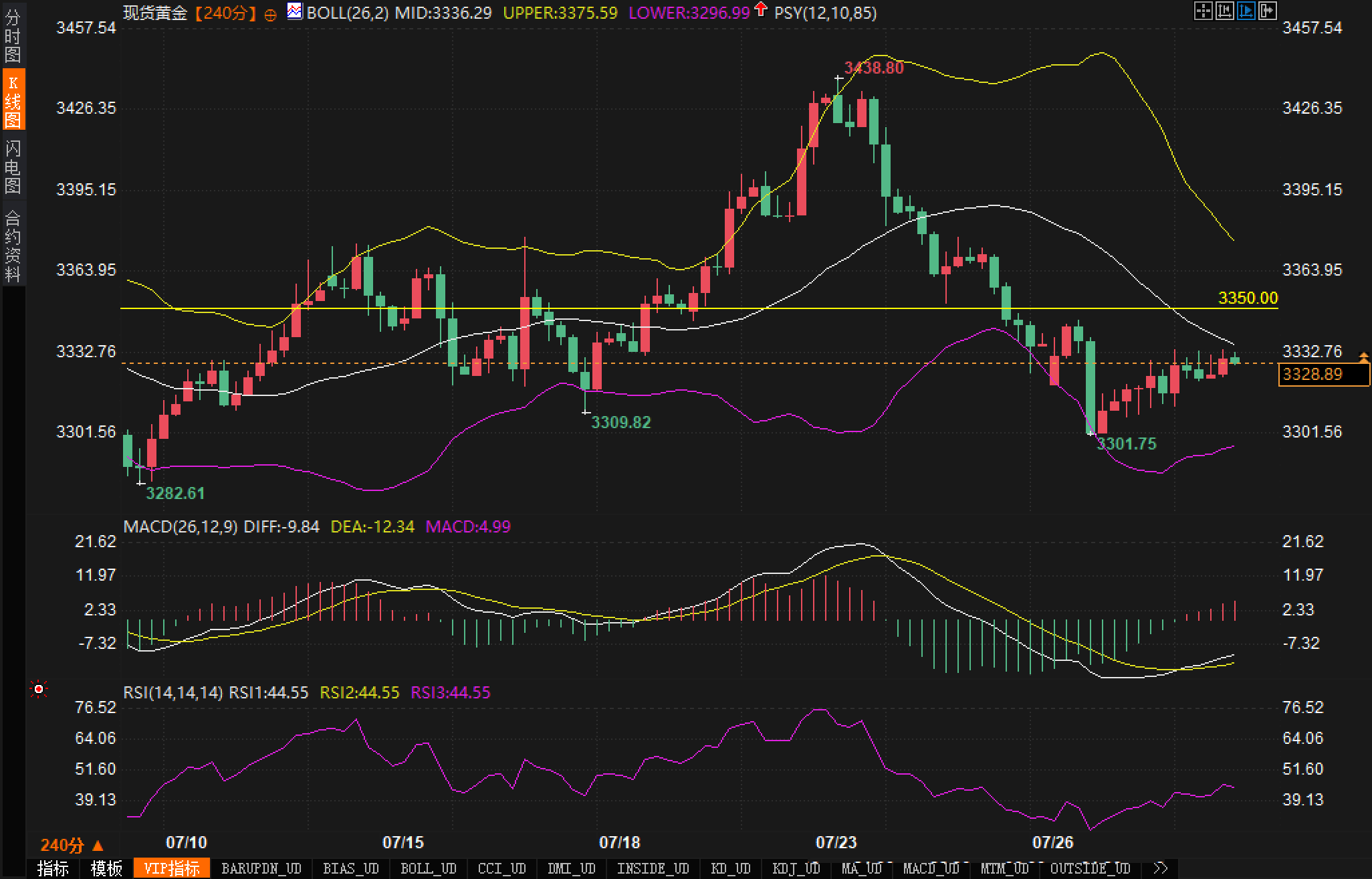Before the Fed’s decision: Will gold break the sideways trend?
2025-07-30 18:58:27

Fundamentals
The gold market this week is driven by uncertainty surrounding macroeconomic expectations and the Federal Reserve's monetary policy. After four consecutive days of gains, the US dollar index has slowed its gains, temporarily retreating to around 99. Traders are still betting on a September rate cut, with the CME FedWatch tool showing a 64% probability of a September rate cut. However, this week's release of Q2 GDP and the core PCE price index data will significantly impact this outlook.
Analysts believe that weak GDP and inflation data will reinforce market expectations of easing, potentially attracting renewed buying for gold. Conversely, strong data could dampen expectations of rate cuts, supporting a stronger dollar and putting pressure on gold. Furthermore, the Federal Reserve is about to hold its interest rate meeting. While keeping interest rates unchanged is almost certain, Powell's speech will be a key focus for the market. Any signals regarding internal disagreements, adjustments to the inflation path, or adjustments to the policy framework could trigger significant market volatility.
From a global perspective, geopolitical risks have remained relatively stable recently, providing no sudden support for gold. Overall, gold currently lacks a single driving factor, with its performance being driven more by expectations.
Technical aspects:
Gold's 240-minute candlestick chart currently shows a typical consolidation pattern. The middle Bollinger Band (3336.29) has become a key equilibrium area for the current price. After a rapid drop to 3301.75, the price stabilized in the short term and subsequently fluctuated between the middle and lower bands.

Observing the K-line structure, the key is the 3350 line, which is the previous bull-bear watershed. Analysts believe that if the price cannot effectively stand above this position, the bearish trend will be difficult to end.
Indicators: While the MACD remains below the 0 axis, its green bar has turned red, and the DIFF and DEA lines have formed a golden cross, reflecting weakening bearish momentum. The RSI is currently at 44.55, in a neutral to weak range. It's not yet oversold, but still some distance from the strong zone.
Overall, the analysis shows that there are initial signs of a short-term halt in the decline in gold, but the technical structure is still a weak rebound and the trend reversal has not yet been confirmed; breaking through the 3350 line can be regarded as a temporary stabilization, and if it falls below 3300, the downward space will be reopened.
Market sentiment observation:
Current market sentiment is in a "wait for a signal" phase. Gold price fluctuations indicate a rebalancing of bullish and bearish forces, with traders remaining highly sensitive to future trends. The narrowing of the Bollinger Bands and declining volatility suggest the market is in a period of compressed momentum, suggesting the possibility of a trend breakout in the near term.
From a sentiment perspective, there has been no significant return of funds to gold. Trading volume has not significantly increased during the technical rebound, reflecting a lack of market confidence. Meanwhile, while the US dollar index has briefly come under pressure, it hasn't seen a reversal, leading traders to opt for a lightened position and wait-and-see approach ahead of the data release.
On the bull side, those betting on loose policies hope to use weak data to boost safe-haven demand and point to a breakthrough in gold prices. On the other hand, bears are focusing on the recent hawkish remarks from the Federal Reserve and the resilience of the U.S. labor market, and tend to believe that current interest rates will remain for some time.
The overall market sentiment is neutral, with a high possibility of short-term changes. Traders are generally wary of rapid fluctuations caused by breaking news.
Outlook for the future:
Bullish Outlook:
Analysts believe that if Q2 economic data released this week falls short of expectations, especially if the core PCE price index shows continued decline in inflation, it will further reinforce market expectations of a Fed policy shift. In this scenario, the US dollar will come under downward pressure, and gold is expected to take the opportunity to break through the 3350 resistance level and challenge 3380 or even 3400.
Technically, if the price can stand firm on the middle track of the Bollinger Band and form a large-volume bullish candlestick, MACD crosses the 0 axis, and RSI rebounds to above 50, a short-term rebound trend will be established, pushing the price upward to test around 3430, which may further trigger a trend continuation.
Bearish Outlook:
Analysts believe that if economic data is strong, especially if core inflation remains stubbornly high, the market may postpone expectations for rate cuts. A rebound in the US dollar and rising real interest rates will put pressure on non-yielding assets, putting gold at risk of a correction. A technical break below 3300 would confirm the current rebound as a "weak correction," with support levels at 3301.75 and 3282.61.
If the MACD indicator forms a second death cross below the zero axis and the RSI falls below 40, it may become a signal for short sellers to increase their positions. In this scenario, gold may enter a deeper correction cycle, and a pullback below the lower Bollinger Band (3296.99) is not impossible.
Mid-term judgment:
Overall, analysts believe that gold is still in a consolidation phase and has yet to establish a unilateral trend. Bulls need to break through 3350 and hold steady, while bears need to break through 3300 and confirm with significant volume. Both technical and fundamental indicators suggest a decisive direction is imminent, and once news becomes clear, the market could enter a trending phase. Traders should monitor key price levels and changes in macroeconomic expectations, awaiting confirmation signals.
- Risk Warning and Disclaimer
- The market involves risk, and trading may not be suitable for all investors. This article is for reference only and does not constitute personal investment advice, nor does it take into account certain users’ specific investment objectives, financial situation, or other needs. Any investment decisions made based on this information are at your own risk.





















